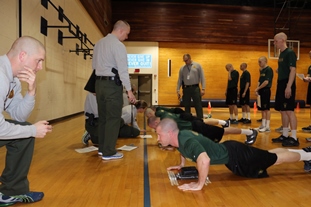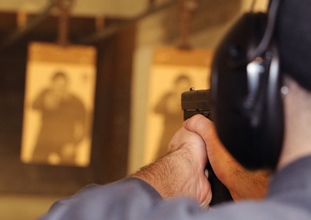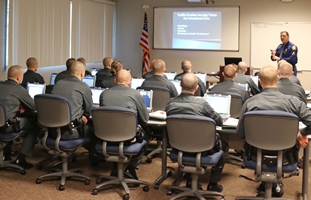No easy sailing despite halfway mark
Week 11: March 13-19
Although graduation June 3 is still several months away, the one woman and 18 men of Recruit School No. 7 have reason to celebrate: They are now halfway through the Michigan Department of Natural Resources conservation officer training academy!
However, this midway point doesn’t mean it’s all downhill from here. Rather, things are ramping up. Increasingly difficult challenges, both mental and physical, still await the recruits as each day builds on the previous.
 Making positive strides Making positive strides
They wouldn’t have to wait long for that next challenge. At 6 a.m. Monday, the recruits reported to the gymnasium for their second of three Michigan Commission on Law Enforcement Standards (MCOLES) physical agility tests. The initial test was held during the first week of the academy. The recruits need to show marked progress in all areas of testing, composed of pushups, situps, a half-mile shuttle run and vertical jumps.
“Every recruit made positive strides,” said Cpl. Mike Mshar, assistant recruit school commander. “When they complete their final test during the last week of the academy, they must meet or exceed standards in order to pass the test and graduate.”
Cpl. Mshar said the recruits still have work to do, but they’re well on their way.
Confessions
After breakfast and morning inspections, recruits reported to the classroom for admissions and confessions instruction by retired MSP Inspector David Greydanus. Training focused on Miranda rights, which require law enforcement officers to warn a person who has been taken into custody of his or her rights to remain silent and to have legal counsel. They also spent considerable time on laws pertaining to the fifth and sixth amendments, which relate to right of counsel and due process of law.
Firearms training
 Firearms training encompassed the next four afternoons (Monday-Thursday) and Friday morning. This was the second of three weeks focused on firearms, which will culminate with an MCOLES qualification course. To carry a sidearm, conservation officers must qualify annually with their firearms. Firearms training encompassed the next four afternoons (Monday-Thursday) and Friday morning. This was the second of three weeks focused on firearms, which will culminate with an MCOLES qualification course. To carry a sidearm, conservation officers must qualify annually with their firearms.
With their issued Sig Sauer .40-caliber handguns, recruits spent firearms training in the Michigan State Police (MSP) shooting range, an indoor facility attached to the MSP training facility. The training facility also houses the conservation officer recruits, where they spend their time living and learning during the 22-week academy.
Recruits began by practicing dry fire drills, meaning there was no ammunition in the guns while firing.
“This technique teaches the recruits the proper trigger pull and the correct way to grip the gun,” Cpl. Mshar said. “Firearm instructors observe the recruits while they dry fire and give them proper training techniques throughout the exercise.”
After the dry fire training, recruits moved to live fire, practicing weapon discharge close to the target. They also practiced timed firing, which introduced them to the skill of firing a designated number of rounds in a set time frame. The qualification course, which recruits must pass to become conservation officers, is timed.
During the week, recruits also practiced shooting in different positions, such as kneeling, standing and from behind barricades like door frames and a wall. They also practiced firing in low light to simulate evening or dusk.
Door to door
Tuesday morning, recruits reported to the gymnasium for morning physical training (PT). During this cardio exercise, called “door to door,” recruits ran outside, around the building and then back inside where they spent one minute completing a set of exercises such as situps or pullups. They repeated this, completing a different set of exercises each time. By the end of PT, they’d done 15 different sets of exercises and ran over 4 miles.
“This is designed to build stamina and strength,” Cpl. Mshar said. “It prepares the recruits for real-life situations where endurance and strength are both needed.”
Traffic crash investigations
Tuesday, Wednesday and Thursday mornings, recruits were in the classroom for traffic crash investigation training with Lt. Gary Megge of the MSP Traffic Investigation Unit. Recruits learned how to properly complete the complex traffic crash report form. They also learned proper procedures for investigating a traffic crash, including determination of how the crash occurred, why it occurred, what happened prior to the crash, and who was at fault.
 This includes documenting evidence such as tire skid marks, impressions and tracks, braking marks and more. They learned how to estimate the speed of the vehicles just prior to the crash and how to determine if and what environmental factors, such as weather, were involved. This includes documenting evidence such as tire skid marks, impressions and tracks, braking marks and more. They learned how to estimate the speed of the vehicles just prior to the crash and how to determine if and what environmental factors, such as weather, were involved.
Marching on
Thursday morning PT began at 5 a.m. sharp. Recruits, in uniforms, boots, duty belts and with weighted backpacks, began a 6-mile formation march.
“The march simulated a common work experience performed by conservation officers,” Cpl. Mshar said. “While on patrol or when searching for lost persons, officers can walk for long distances through large wooded areas carrying their patrol gear and first aid equipment.”
Friday afternoon, after reviewing an exam taken Thursday evening, recruits were dismissed for the weekend. Next week would bring the culmination of firearms training, more traffic crash investigation and the introduction of new topics, including weapons of mass destruction.
Subscribe to the weekly conservation officer academy blog, which also is posted weekly on the Michigan DNR Facebook page. View past blogs from Recruit School No. 7.
/Photo details: Accompanying photos are available below for download. Caption information follows.
Physical agility test.jpg: Recruits did pushups during the second of three Michigan Commission on Law Enforcement Standards (MCOLES) physical agility tests. The test also includes situps, a half-mile shuttle run and vertical jumps. In order to graduate from the academy, recruits must meet or exceed designated standards. Their final physical agility test will take place the week of graduation.
Firing range.jpg: Recruits spent considerable time training in the Michigan State Police firing range this week. This was the second of three weeks of intensive firearms instruction and training.
Traffic crash instruction.jpg: Lt. Gary Megge of the Michigan State Police Traffic Investigation Unit conducted traffic crash instruction in the classroom this week./
The Michigan Department of Natural Resources is committed to the conservation, protection, management, use and enjoyment of the state’s natural and cultural resources for current and future generations. For more information, go to www.michigan.gov/dnr.
|

 Making positive strides
Making positive strides Firearms training encompassed the next four afternoons (Monday-Thursday) and Friday morning. This was the second of three weeks focused on firearms, which will culminate with an MCOLES qualification course. To carry a sidearm, conservation officers must qualify annually with their firearms.
Firearms training encompassed the next four afternoons (Monday-Thursday) and Friday morning. This was the second of three weeks focused on firearms, which will culminate with an MCOLES qualification course. To carry a sidearm, conservation officers must qualify annually with their firearms. This includes documenting evidence such as tire skid marks, impressions and tracks, braking marks and more. They learned how to estimate the speed of the vehicles just prior to the crash and how to determine if and what environmental factors, such as weather, were involved.
This includes documenting evidence such as tire skid marks, impressions and tracks, braking marks and more. They learned how to estimate the speed of the vehicles just prior to the crash and how to determine if and what environmental factors, such as weather, were involved.




